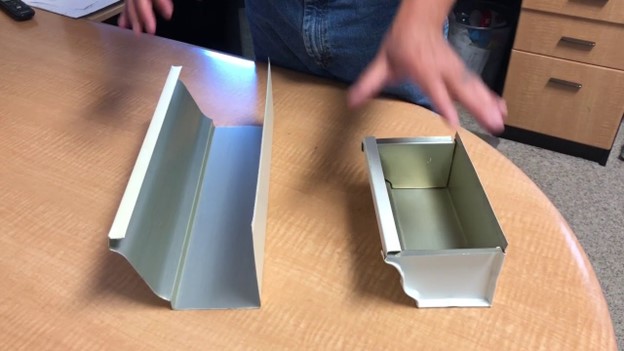Are you planning on installing gutters in your new house or replacing your old gutters, and you’re puzzled between 5- or 6-inch gutters? To save you the hassle of researching the differences and benefits of each size, we have put together a guide to help you choose the correct size gutters for your home’s needs.
Gutters play a crucial role in protecting your home from water damage, and choosing the right size is essential to ensure they function correctly. This guide will help you understand the differences between 5 and 6-inch gutters and how to choose the right size for your home.
What are Gutters and Why are They Important for Your Home?
Have you ever thought about gutters’ importance in your home? Many people overlook this crucial part of their homes’ maintenance list, but gutters protect your home from severe water damage. Gutters are designed to collect rainwater from your roof and channel it to the ground, preventing mold, mildew, and other water damage.
Without a gutter system, rainwater would collect on your roof, leading to rot, deterioration, and mold. This is where gutters come in; they channel all the water away from the base of your house, feeding it into designated areas around your yard. Gutters are an excellent way to prevent rain and water damage to your home.
Benefits of Gutters
Your roof collects an average of 1,120 gallons of water for every inch of rainfall. Imagine that amount of water pooling around your home’s foundation; it would lead to a disaster. But thanks to gutters, the water rolls down from the roof’s slope and travels through the gutter system to the downspout. The downspout carries the water from the gutters to the base of the house, protecting the basement and foundation from flooding and further water damage.
- If your home is located at the bottom of hills or slopes, rainwater from these slopes can build up around your home’s foundation, causing damage, settlement, and mold. Gutters are the best way to prevent this from happening.
- You will also need gutters if you have a basement, especially a finished one. Without gutters, water can enter your home and cause basement flooding. Gutters can also protect crawl spaces from water damage.
- Gutters help avoid trench formation around your home’s foundation that can lead to severe and costly damage. If your roof’s overhang is close to your home’s siding, gutters prevent rainwater from causing damage to your home.
- Gutters help stabilize the soil around your house, prevent foundation problems, avoid flooding under houses and in basements, prevent erosion, water damage to siding, water staining on brick and stone masonry, settling and cracking of sidewalks, patios, and driveways, and preserve exterior doors and overhead garage doors.
What’s the Difference Between 5- and 6-inch Gutters?
So you’re stuck trying to decide between 5 and 6-inch gutters, and you’re not sure which one fits your home best. Don’t worry because we’ve got you covered. While the difference may seem insignificant, the size of your gutters can significantly impact how well they work to protect your home from water damage.
First things first: what’s the difference between 5-inch and 6-inch gutters? The answer is simple: the size of the mouth at the top of the gutter. 6-inch gutters have a wider mouth, holding up to 50% more water than 5-inch gutters. That’s a big deal, especially if you live in an area with heavy rainfall or frequent storms.
But that’s not the only difference. 6-inch gutters are also wider than 5-inch gutters, which means they can cover the entirety of your fascia board. The fascia board is the board that runs along the edge of your roof and supports the gutters. If you have 5-inch gutters, a small piece of the fascia board will be exposed, which means you’ll need to paint it every three to five years. With 6-inch gutters, the entire face of the fascia board is covered, making it essentially maintenance-free.
Another advantage of 6-inch gutters is that they have a wider gap between the shingles and the gutter. With a 5-inch gutter, the gap can be as small as two inches because a shingle overhang is long. With a 6-inch gutter, you have more room for your hand to fit in, making it easier to clean and maintain.
Which One is the Best Choice?
So, which one should you choose? It depends on a few factors. If you live in an area with heavy rainfall or frequent storms, 6-inch gutters may be the better choice. They’ll be able to handle more water and protect your home from water damage more effectively. If you’re looking for a maintenance-free option, 6-inch gutters may also be better because they cover the entire fascia board.
On the other hand, if you don’t get a lot of rainfall and are on a tight budget, 5-inch gutters may be the better choice. They’re less expensive than 6-inch gutters and can provide adequate protection for your home.
In the end, the choice is yours. Whether you go with 5- or 6-inch gutters, ensure they’re installed correctly and regularly maintained to keep your home safe from water damage.
The Impact of Heavy Rainfall on Gutter Size
When it rains heavily, it’s important to have a gutter system that can handle the water flow. Your home can suffer from damage if your gutters aren’t the right size for the job. Blockages from leaves, moss, or other debris can cause water to overflow your gutters. If your gutters are too small for the amount of rainfall, they will overflow.
Conversely, if the gradient of the gutter is too steep, water will overflow at the top or bottom of the downpipe. If the gradient is too small, water will sit in the gutters and eventually overflow.
When it rains heavily, gutters can fill up quickly, and water can spill over the edges and run down your siding to your foundation. This can cause soil shift around the foundation, leading to cracks. Heavy rainfall can also damage your landscaping. So, ensuring your gutters are the right size to handle the water flow from your roof is essential.
If your gutters are not designed to handle heavy rainfall, you may need to replace them. This will prevent damage to your home and landscaping. You can install water storage installations like water tanks to store water from heavy rainfall. You can use this stored water to offset the cost of domestic water usage and help recoup your outlay.
Don’t wait for heavy rainfall to cause damage to your home. Take the time to ensure your gutters are the right size for the job. Invest in increasing the capacity of your gutters to protect your home from damage caused by heavy rainfall.
How to Determine if You Need a Larger Gutter Size
Do you need a larger gutter size? The answer is based on several factors, including the steepness of your roof, the square footage of your roof’s plane, and the size of your downspouts. To determine if you need a larger gutter size, you can start by using the roof-pitch factor. The roof-pitch factor tells you the steepness of your roof and can be calculated with a two-foot level and a tape measure.
Roof Pitch
Once you know the pitch of your roof, you can find your roof-pitch factor in a table. The roof-pitch factor table includes different roof pitches ranging from 12 in 12 or higher to flat to 3 in 12. The table gives you an idea of the gutter size that you will need. For instance, if your roof’s pitch is between 4 in 12 to 5 in 12, you will need a gutter size of 1.05.
If you recently replaced your roof and the contractor extended the shingles more than 1.5 inches past the roof edge, you may need a larger gutter size. This is because water may overshoot the gutter during a heavier rainstorm.
Roof Plane
Another factor to consider when determining if you need a larger gutter is the square footage of your roof’s plane. If your roof’s plane is between 600-800 square feet, 5-inch gutters are recommended. However, if your roof’s plane is 1,400+ square feet, you should consider going for 6-inch gutters, as this will allow doubling the amount of water going into your gutters.
Size of Downspouts
Remember to consider the size of your downspouts when sizing your gutters. If you are installing new downspouts with your gutters, make sure your gutter contractor calculates their size based on the maximum amount of rainfall your area experiences. Downspouts are an essential component of efficient drainage, and if the gutter can run stormwater quickly away from the roof but encounters a choke point at the downspouts, the width of the gutters will make little difference.
Gutter Style
Lastly, the style of gutter you use should be considered when sizing your gutters. K-style gutters are deeper and offer better water flow than half-round gutters. However, both gutters would serve you better when sized at 6 inches.
The Cost Difference Between 5- and 6-Inch Gutters
When it comes to gutters, the cost is always a consideration. The price difference between 5-inch and 6-inch gutters can be a deciding factor for homeowners. On average, 6-inch aluminum gutters cost about 50 cents to 1 dollar more per foot than 5-inch gutters. It’s simple math to say that the larger size will cost more.
Sectional gutters, which come in lengths of 5-, 10-, and 15-foot precut sections joined on-site, are more affordable than seamless gutters. Depending on the material sectional gutters can cost anywhere from $3 to $20 per linear foot. Seamless gutters, on the other hand, can cost between $800 and $5,000, or $4 to $30 per linear foot, depending on the material, according to Bob vila.
For a home that requires 5-inch gutters, it’s recommended to have two downspouts if the gutter run is 40 feet or longer. Each downspout should be around 15 feet in length. The average cost for 5-inch aluminum gutters is $8 to $8.50 per foot installed.
While 6-inch gutters cost slightly more than 5-inch gutters, the benefits outweigh the price increase. Investing in larger gutters can save you money in the long run by preventing water damage to your home. With more oversized gutters, water is better managed, reducing the risk of water overflowing and causing damage to your roof or foundation.
At HomeCraft Gutter Protection, we believe in transparency and educating our clients. We’ll provide you with all the facts so you can make an informed decision about your house. You will feel free to get more oversized gutters or high-end gutter guards if they’re not necessary for your property. We’ll help you find the perfect gutter size and material that fits your needs and budget.
Maintaining and Cleaning Your Gutters, Regardless of Their Size
Maintaining and cleaning your gutters is crucial to the overall health of your home or business, regardless of whether you have five or 6-inch gutters. Neglecting this important task could result in serious structural and safety risks that you could have avoided with a simple cleaning.
Gutters are meant to funnel water away from your building, but with proper maintenance, debris can accumulate and clog the channels, rendering them useful. This could cause leaks, sagging, and even costly foundational damage. To avoid these issues, it is recommended that gutters be cleaned twice a year by a qualified and insured maintenance contractor.
If you use in-house maintenance personnel, they must follow all safety procedures and requirements when working at heights. It would help if you secured ladders properly, and you should always wear safety equipment to prevent falls and injuries.
While cleaning your gutters regularly may seem like a hassle, it is a small price to pay for the protection they provide to your entire home or business. Pay attention to this vital component of your building’s structural integrity. With just a little maintenance, your gutters can continue functioning properly and keep your property safe and dry.
Frequently Asked Questions
Can I install gutters myself, or do I need to hire a professional?
It is possible to install gutters yourself if you have the necessary tools and experience. However, if you need clarification on the process, it’s best to hire a professional gutter installer to ensure that your gutters are installed correctly.
How often should I clean my gutters?
It would help if you cleaned your gutters at least twice a year, ideally in the spring and fall. However, if you live in an area with many trees, you may need to clean your gutters more frequently.
Are there any other factors to consider when choosing the right size gutters for my home?
Yes, there are several other factors to consider, including the size of your roof, the pitch of your roof, the amount of rainfall in your area, and the size of your downspouts.




